The Pheasant tail nymph (PTN), in one form or another, has been taken without hesitation by countless generations of trout and grayling for over 100 years. Probably because these artificial nymphs closely resemble a range of aquatic insects.
As such, it’s wise to have a few patterns of this century-old classic in your fly box for fishing rivers and stillwaters.
I do, and…
Over the years, they have caught plenty of trout and grayling on the rivers I fish in the North West.
On scouring the fly fishing literature you’ll find many PTN fly patterns that anglers use. I’ve tied and fished many of them over the years, but now I only tie and fish a small selection that consistently catches trout & grayling for me.
So…
What are my best pheasant tail nymph patterns?
In addition to sharing the PTN patterns, I will explain how and when to fish each of them.
First and foremost, is…
Frank Sawyer’s pheasant tail nymph
I love this classic pattern for a number of reasons:
- It catches fish
- It’s simple
- Easy to tie
Furthermore, if you are starting your fly tying journey you only need two fly tying materials, i.e. fine copper wire and pheasant tail feathers.

Frank Sawyer’s PTN
- HENDS BL354 hook sizes 12 – 16
- Fine copper wire as thread
- 4 to 5 pheasant tail fibres
Davie McPhail produced a great video on how to tie a pheasant tail nymph. It’s a simple but deadly nymph…
Usually, I fish this Sawyer’s PTN as the point fly with two wet flies or spiders on two droppers spaced 3ft apart.
For example, to cover all the bases in the absence of rising fish, I’ve found this team of 3 wet flies rarely fails to catch trout and grayling (point: #12 Sawyer’s PTN; middle dropper: #14 black hopper; top dropper: #14 March Brown spider).
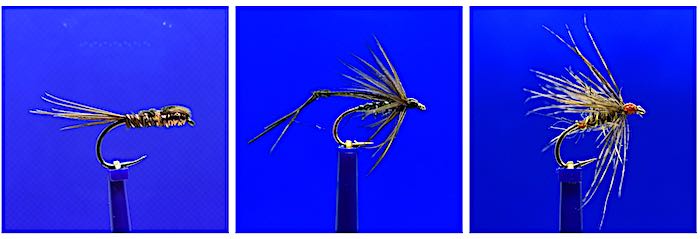
For me, Sawyer’s PTN works best when fishing water with enough pace that the fish will have to make a snap decision on taking the fly.
Whereas, for slower sections where fish have more time to observe the fly, it’s better to fish a PTN with additional features to make it more representative of natural nymphs.
PL Pheasant Tail Nymph
I designed the PL pheasant tail nymph to be more life-like to tempt the selective feeding trout and grayling.
Adding the partridge legs (PL) increases the complexity of the tie, but it’s worth the additional effort to have some in your fly box for when Sawyer’s PTN fails to work.
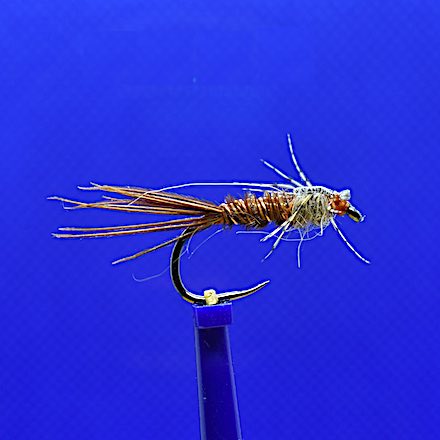
PL-PTN recipe
- Hook – HENDS BL354 (#12 to 16)
- Thread – Tan 8/0 Uni
- Tail – pheasant tail fibre tips
- Body – pheasant tail fibres
- Rib – fine copper wire
- Thorax – Hare’s Ear dubbing
- Legs – Partridge neck feather
- Wing case – WASPI Mottled Oak Thin skin
Opal Throat Pheasant Tail nymph
The pheasant tail nymph with an opal throat has a special place in my fly box for when trout are feeding on fry in the margins, especially in the evening towards the end of the season.
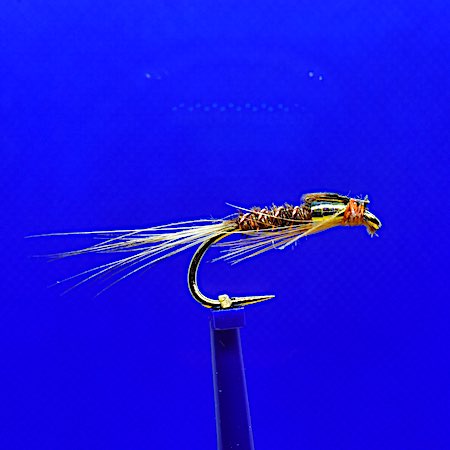
Opal Throat PTN recipe
- Hook – FULLINGMILL FM15 30 (#10 to 14)
- Thread – Tan 8/0 Uni
- Tail – ginger cock fibres
- Body – 5 pheasant tail fibres
- Rib – fine copper wire
- Thorax – Mirage Opal tinsel
- Thorax cover – pheasant tail fibres
- Hackle – ginger cock
I fish the Opal PTN on the point of a long leader (10+ ft) in slow pools where fry tend to congregate. It often works best by casting the fly across to the other bank, letting it swing around into the margins, and retrieving it with a slow figure of eight. Takes are often fast and only a slight raise of the rod is needed to set the hook.
PTN selection for euro nymphing (short-line nymphng techniques)
The above pheasant tail nymphs are my preferred choice for nymphing in shallow water glides etc. However, in deeper water, I use PTNs specifically designed for short-line nymphing techniques.
When euro / Czech nymphing, my default set-up consists of fishing a team of three nymphs spaced 18″ apart on a 4lb fluorocarbon tippet.
The point nymph will often be either of the following two pheasant tail patterns, with the choice depending on the fishing condition.
Pheasant tail jig nymph
At the start of the trout season, the pheasant tail jig-nymph is my preferred point nymph.

PT jig nymph (orange tag)
- Hook: Hends BL154 (#12 & 16)
- Bead: 2.5mm tungsten (silver & gold)
- Thread: Brown UNI-Thread 8/0
- Tail: 3 pheasant tail fibre
- Body: pheasant tail fibres
- Rib: Fine copper wire
- Thorax: Olive dubbing
It’s a versatile nymph pattern and can be tied with or without the orange tag and different coloured tungsten beads (neutral, silver, gold, and copper).
Pink collar Pheasant tail nymph
The pink collar PTN is my point fly of choice when the grayling fishing season is in full swing, especially on the Welsh Dee from November to February.
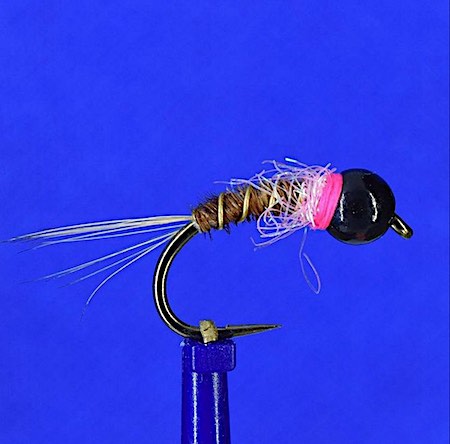
Pink collar PTN
- Hook: Kamasan B100 (#12 & 14)
- Bead: 3 or 3.5mm black tungsten
- Thread: pink UNI-Thread 8/0
- Tail: olive cock hackle fibres
- Body: pheasant tail fibre
- Rib: copper wire
- Collar: Veniard glister sparkle pink dubbing
It’s a versatile pattern, which I tie using a range of coloured tungsten beads, e.g. black, gold, copper, etc.
The black or neutral tungsten bead versions are best for fishing in clear water. However, the versions tied with silver, gold, or pink tungsten beads have the edge in cloured water.
Micro Pheasant Tail nymph
The micro PTN is a versatile pattern for fishing on the middle or top dropper of a short-range nymphing set-up.
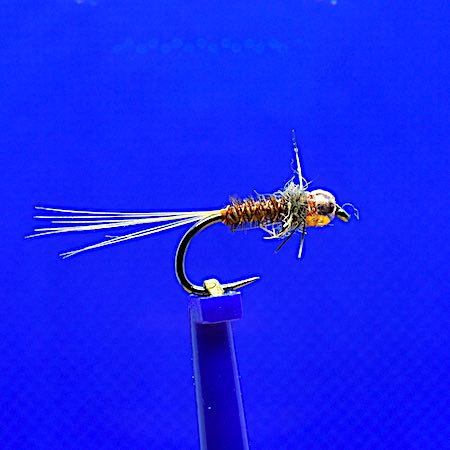
Micro PTN
- Hook – HENDS BL354 (#16 to 20)
- Bead – 1 to 2mm tungsten
- Thread – Tan 8/0 Uni
- Tail – ginger cock tips
- Body – pheasant tail fibres
- Rib – fine copper wire
- Thorax – Hare’s Ear dubbing
I’ve caught some great trout and grayling fishing this micro PTN in clear water (ca. visibility > 3 ft).
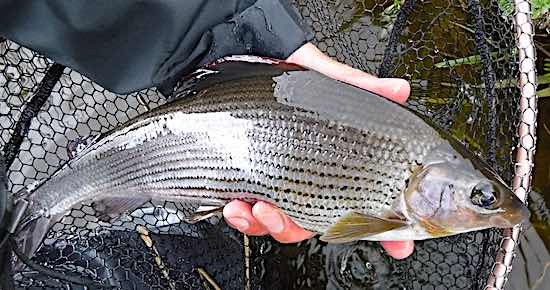
Matching the nymph size with the natural nymphs that fish are feeding produces the best results, which can mean fishing a size 18 or smaller.
Endless variations of PTN are possible, only limited by your imagination and the availability of pheasant tail fly tying materials. Three of the micro PTN that I regularly fish are…
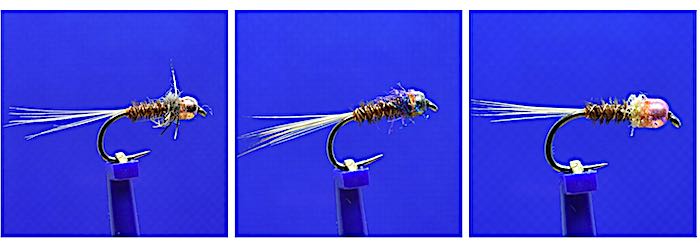
I hope you’ve found this article on my preferred PTN recipes for trout and grayling fishing on the Welsh Dee useful.
If you don’t tie flies, FULLINGMILL and Peaks Fly Fishing sell a range of pheasant tail nymphs. Finally, it would be great if you could share the PTN patterns that have a special slot in your fly box.
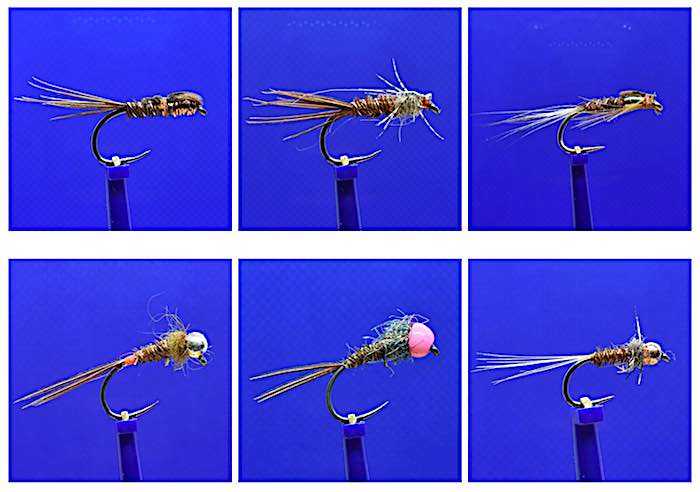
Been meaning to start with some PTN patterns and there are great examples. Thanks. Andrew
Hi Andrew,
Glad that this post was useful. Let me know how you get on fishing the PTN patterns you tie.
Cheers, Andrew
Excellent examples of the variants
Cheers
Great fies, as usual Andrew. You like the tails quite long, is that cosmetic, or do you think it makes the fly sink more quickly? I have read that longer tails can make them sink head first, and hence in a more streamlined and quicker fashion, but have never really tried it in practice.
Hi Donald,
I like to tie them decent tails because I think the flies move more in the current and make the flies appear lifelike. However, they still seem to catch fish when the tails have been lost so not sure it really makes a difference.
Cheers, Andrew
Hi Andrew, as usual very interesting and informative, have you ever tried the mono rig for nymphing? I’m just starting out on fly-fishing, only managed one session on Dee so far, at Halton, small sea trout on traditional wet and couple of small grayling on dry, I found nymphing very difficult.
Hi Paul,
Never tried fishing the mono-rig but I have watched a video of someone in the US using it to great effect with a lump of shot about 6″ above the fly.
Cheers, Andrew
The R Dane is my home water and I fish the mono rig (.22mm, 12lb ish) extensively. Very effective at short range and very quick and easy to change between sighter (EN), Dry-Dropper, and Yarn Indicator. I keep these rigs on winders and use a micro loop on the end of the mono rig for rapid change over (I’m not keen on tippet rings).
Hi Nick,
I’ve fished the Dane a couple of times on the PAAS stretches with variable success, from catching plenty to struggling to get off the mark. Where do you fish?
Cheers, Andrew
Great flies Andrew , the pearly thorax nymph looks a cracker ,
Hi James,
It is a great fly especially when trout are feeding on pin-fry in rivers and lakes.
Cheers, Andrew
Wonderful simple pattern , and deadly on the river. Thank you Davie.
Hi Keith,
Great to hear you enjoyed the post.
Cheers, Andrew
Great article on PTN. A Favourite pattern(s) for me. Really appreciate the effort you put into sharing your knowledge, keep it t! Thanks.
Great to hear you are enjoying them.
Cheers, Andrew
Brilliant information and well explained , any of these articles are worthy of your attention , the sections on how to fish certain Rivers and beats are amazing, and a lot of the flies willcatch you some fish whereever you cast a line . keep it up and thank you!
Hi Robert,
Great to know that you are enjoying the website. Also, thanks for the useful feedback about the sections you are amazing.
Cheers, Andrew
Thanks Andrew , still now I’m wondering why this pattern with his stiff innatural tail is so attractive , and so far on imitating any kind of natural nymph shape , one of the thousands fly fishing intriguing mysteries
I’ve done quite a bit of sampling nymphs on rivers and watching them swim under the microscope. So, have two comments that might help:
First up, most of the natural nymphs are various shades of brown.
Secondly, when moving in the water their tails don’t seem to move very much.
I hope this helps, Andrew
Hi Andrew, there is little to beat the tried and tested flies like the PTN and the GRHE. They still catch fish and are timeless. Keep up the articles. Tight Lines.
Will try my best.
A fly is composed of fur feather and string, when you add a sliver or gold bead then it becomes a quasi – lore.